This was our first view of Mont St Michel, probably about 5 miles from the coast. Just stunning to see. I took so many pictures from every angle today!
We got there in good time and drove past a LOT of very empty parking places. I was so glad we were not here during peak season. We took a shuttle bus across the connecting bridge to the island and began to explore. The shuttle bus was like a subway train - it had a drivers compartment at both ends of the bus! We watched the driver move from one end to the other after he reached the end of the bridge and open the doors of the bus on the other side to admit passengers.
We found a nice out of the way outlook and had a picnic lunch with fresh croissants, meat and cheese. Then it was time for our tour of the Abbey at the top of the island. I don't have any idea how many stairs we climbed, but I'm guessing about 10 flights worth. (Unlike many other locales, there were no signs warning you about how high the climb was.)These are the rocks we sat on for lunch. We didn't learn until later that the island is shaped like a pyramid, so in order to build the abbey on top, they had to build around the central pile of stone and put enough supports in to carry the load of the full sanctuary at the top. These are some of the rocks that were native to the small island. They stick out here and there from the masonary of the walls.
The tour guide was great. The original complex was built by the Benedictine order around 1000 AD and then added to over the years. The monks left the complex during the French revolution and it was used for a time as a prison until 1863. Over 14,000 prisoners passed through the island prison. Major restoration work began in 1874 and continues to this day. It was classified as a UNESCO world heritage site in 1979. |
We arrived at low tide and stayed for the full afternoon, eventually seeing high tide that covered the sand flats behind us.
So many stairs!
The sky was mostly cloudy today, but there were times when the sun peaked through and the changing clouds were very pretty.
Looking back across the bridge from the top of the Abbey.
This was the highest level we got to see. They offer a tour of the flying buttress supports and the roof, but I didn't manage to get a reservation early enough. Maybe next time. The golden angel you can see at the top of the spire is St. Michel.
Looking out into the bay. There is a smaller island (Tombelaine)in view to the right that you can hike to when the tide is out.
In the far distance are granite cliffs where the stone for the construction was quarried.
The sanctuary is a mix of Romanesque and Gothic design. The apse is gothic with the ribbed arches.
The nave below is romanesque with the barreled vaulted ceiling. It is wooden and was restored in the 1800s. The center chancel is on the top of the island rock at 80 m above sea level.
Bishop Aubert is the found bishop of the abbey. He supposedly had a vision to build the abbey on the small island. He ignored the vision twice, but the third time the arch angel St Michel reached down and touched his head. You can see this image in the sculpture below.
Apparently after his death, the bishop's skull became a reliquary. You can see the hole in the skull below. Delaney and I have speculated about this and she's going to ask her forensics professor about it.
After the sanctuary, we began the tour at the top level of the complex. There was a pretty cloister. The arches had detailed carved and painted leaves to resemble the Garden of Eden.
This is the refectory where the monks ate their meals. In Benedictine fashion, they did not speak during meals, but below you can see a small elevated pulpit where scripture was read during meals. There were only 40 or so monks here, but the dining hall was quite large.
This was the floor beneath the refectory where meals were prepared (see the enormous hearths below), and where noble visitors stayed. This was a warmer room and painted with bright colors. It even had access to a privy in a corner of the room. The guide said the windows were large to lighten the weight of the walls that were supported by the vaults below.
This picture and the one below are in the crypts that were built around the peak of the pyramid shaped island. They were irregularly shaped to form a foundation for the sanctuary that was level with the top of peak.
My eye was constantly drawn upward to the shear walls reaching to the sky.
The abbey has a manpowered 'gerbil wheel' that pulls a sledge up a track on the slope to bring in supplies to the complex. This one is reconstructed dating to the 1820's to haul supplies to the prison. It is modeled after the one that was originally used to haul building materials up to the mount.

This is the sledge track looking down from the mounted wheel. (above)
Below is looking at the track from the bridge (its in the center of the picture going up to an arched opening)
This is the sledge where goods could be tied on to be pulled up the slope.
You can see some of the native rock to the island as part of the wall here in the crypts.
(They were never used for burials, mostly just for food storage)
This room was the scriptorium where the monks would copy manuscripts. It was well lit and warm and helped keep the manuscripts at a good temperature for preservation. These are now preserved in the nearby town of Avranches.
You can see the walls built around the nature rock outcroppings.
A view of the small village on the lower level of the island.
After the tour we wandered the paths back down to the rampart walls. We saw a lot of cats sprawling on walls and in the small gardens of the hotels!
A village grew up around the base of the abbey. It was filled with hotels, shops and restaurants.
It reminded us of Diagon Alley.
The outer walls resisted attacks by the English for hundreds of years.
We got to see a very cool tidal effect at the end of the day. The tide comes in very quickly and can change up to 15 m. There are 3 rivers that empty into the bay and when the tide comes it, it visibly reverses the direction of the streams. This group was standing in place as it happened. It was just this sudden ripple moving across the water and up the river bed. Very cool to watch.
Low tide
Same view with tide coming in
We decided to find a restaurant overlooking the bay for dinner and then head back to Caen. I had the traditional Poudelle omelette. It was super fluffy eggs with some flour/batter in it. It was a dish that a local woman fixed for the pilgrims who would come to the abbey.
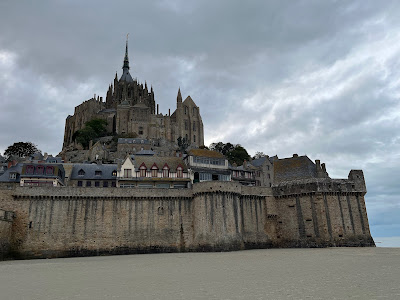
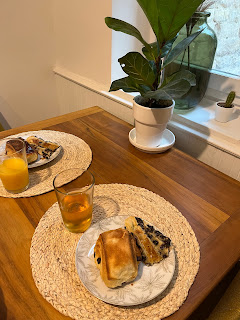









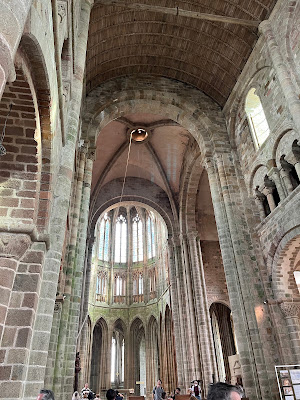







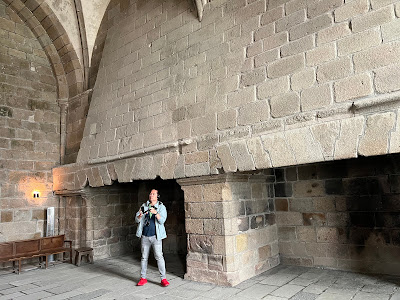










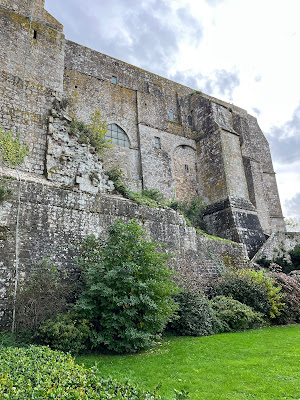






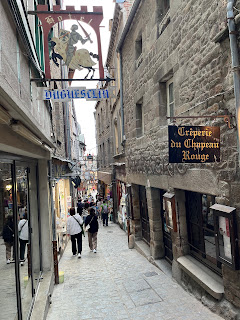





No comments:
Post a Comment